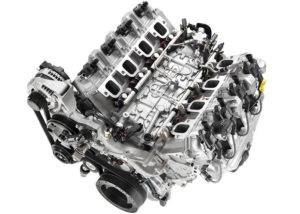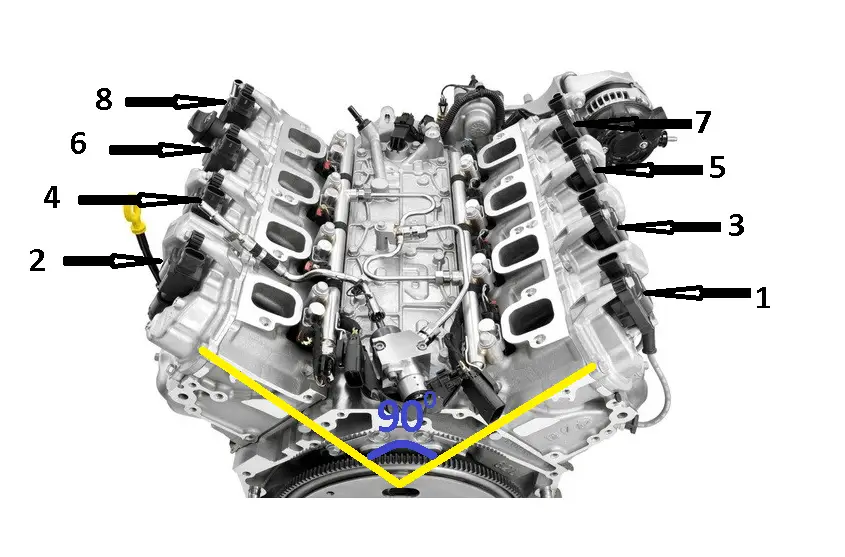In this post, you will learn what is V8 Engine and How it works? and its Working, Construction, and Advantages of V8 Engine.
You can also download the PDF file at the end of this article.
V8 Engine
The V8 engine is also known as the Eight-Cylinder engine. These Eight-cylinder engines have the cylinder setting either of V-type or vertical straight. The V8 is the engine that represents American motoring, but it is loved worldwide.
The V8 engine gets its name from having a cylinder block shaped like a “V” with eight cylinders.
In the V8 engine, the eight-cylinder is set in two sets of 4 cylinders in lines making the V. Two cylinders operate from a single crank because it allows faster acceleration and more efficient exhaust system designs.

The angle V is 90°. When piston N0.1 on the left is at T.D.C., piston No.1 on the right completes half of its downward stroke.
Although the primary inertia forces are balanced in V-8 engines, the secondary forces are out of balance and tend to induce a horizontal vibration which generally requires using a friction damper to neutralize it.
Different V-8 manufacturers number their cylinders differently; thus, firing order numbering systems differ. This engine operates under the same basic principles as gasoline four-stroke engines.

You might like: List of Basic Engine Components [Working Explained]
V8 Engine Working [How Each Cylinder Works]
Following is the working of the V8 Engine:
Let’s focus on how one cylinder works.
- First, the piston draws in air and fuel as it moves downward.
- Then it compresses that air and fuel as the piston moves upward.
- Next, a spark plug sparks ignite the air-fuel mixture and force the piston downward.
- Finally, the piston pushes out the exhaust gasses on its way back up before the cycle repeats itself.

In the V8 engine, this cycle happens in eight cylinders at different times, with these 8 cylinders firing for every 90 degrees of the crankshaft revolving. It means that at any point, there are two cylinders on the power stroke.
Methods of Numbering Cylinders in V8 Engines
The fig shows three methods of numbering cylinders in V-8 engines. The arrangement as at A is used in Motorcars, in which the firing order is
1 – 8 – 4 – 3 – 6 – 5 – 7 – 2
The Oldsmobile has the firing order,
1 – 8 – 7 – 3 – 6 – 5 – 4 – 2
The cylinder arrangement as at (B) is used in Ford, Mercedes, and Lincoln with a corresponding firing order of,
1 – 5 – 4 – 8 – 6 – 3 – 7 – 2
or
1 – 5 – 4 – 2 – 6 – 3 – 7 – 8
The cylinder arrangement as at (c) is used in Buick engine with a firing order of,
1 – 2 – 7 – 8 – 4 – 5 – 6 – 3
In the straight type arrangement, the eight-cylinder is arranged vertically inline, using a crankshaft with the throws set at 90° from each other.
Four crank throws are in the horizontal plane and four in the vertical plane, forming a cross in the side view.
The power impulse is at every 90° movement of the crankshaft. The firing order in straight American engines is,
1 – 6 – 2 – 5 – 8 – 3 – 7 – 4
Other orders of firing may be,
1- 7 – 3 -8 – 4 – 6 – 2 – 5
and
1 – 5 – 2 – 6 – 4 – 8 – 3 – 7
The straight-8 engines are more compact in width than V-8 engines. They are balancing for both primary and secondary inertia forces.
Read Also: What Is Knocking In Engine? [Their Causes & Remedies]
Crankshaft Configuration in V8 Engine
The crankshaft is installed in two configurations in the v8 engine, which are explained below:
#1 Cross-plane Crankshaft
A cross-plane crankshaft is used in nearly all V8 engines installed in road vehicles. Because of the perfect primary and secondary balance, this configuration produces less vibration. When viewed from one end, the cross-plane crankshaft has a cross shape because the four crank pins (numbered from the front) are at angles of 0, 90, 270, and 180 degrees.
A typical cross-plane V8 engine’s signature rumbling exhaust sound is partly caused by the uneven firing order within each of the two banks of four cylinders. When the firing order is L-R-L-L-R-L-R-R (or R-L-R-R-L-R-L-L), there will be uneven pulse spacing between intake and exhaust pulses.
This uneven pulsing produces the rumbling sound typically associated with V8 engines when separate exhaust systems are used for each bank of cylinders.
In the 1960s, cross-plane V8 engines utilized long primary exhaust pipes (like the Ford GT40 endurance racing car) or had exhaust ports on the inside of V-angles (like the Lotus 38 IndyCar) to connect exhaust systems from each bank.
#2 Flat-plane Crankshaft
Many V8 engines used in racing cars have flat-plane crankshafts. This configuration has two advantages. Mechanically, the crankshaft is lighter because it can be machined from a flat billet and does not need counterweights. It vibrates more as a result of a secondary imbalance.
From the perspective of gas dynamics, the flat-plane crankshaft enables the production of even exhaust gas pulses with a basic exhaust system. In motor racing, the design was popularized by the 1961–1965 Coventry Climax FWMV Formula One engine, and the 1967–1985 Cosworth DFV engine achieved great success.
The Lotus Esprit V8, Porsche 918 Spyder, and McLaren MP4-12C are just a few production sports cars that use flat-plane V8 engines. A flat-plane crankshaft was also used in most early V8 road car engines because it was easier to design and build than a cross-plane crankshaft.
Advantages of ‘V’ Type Engines Over Inline Engines
Although inline 8-cylinder engines were once widely used in automobiles, they have been replaced by V8 engines due to having some advantages.
The following are the advantages of the V8 Engine:
V8 engine permits a shorter, lighter, and more rigid engine. The more rigid engine allows higher running speeds and higher combustion pressure with less difficulty from flexing or bending the cylinder block and crankshaft. Flexing forces the engine out of line, increases frictional losses and wear, and it may also set up internal vibrations.
The shorter engine permits more space for a passenger on the small wheelbase. The lighter engine provides the vehicle to be light.
It permits using an intake manifold that assures relatively even distribution of the air-fuel mixture to all cylinders since all cylinders are relatively close together.
It permits lowering the hood line and, thus, a lower car profile. This is due to the carburetor and other parts being rested between the two rows of cylinders so they do not take up headroom above the cylinders.
Conclusion
So now, we hope that we have cleared all your doubts about the V8 Engine. If you still have doubts about the “V8 Engine,” you can contact us or ask in the comments.
That’s it. Thanks for reading. If you like our article, then please share it with your friends. If you have any questions about any topic, you can ask in the comment section.
Subscribe to our newsletter to get notified about the new posts when we upload.
Download PDF of this article:
You may be interested in reading this article:
- What is a Quadra Steering System?
- What is Supercharger: Its Types, Working Principles, and Advantages
- 6 Most Common Problems of Cooling Systems
- How Does a Torque Converter Work?
- Different Types of Fuel Pumps and Its Working Principle
- 9 Different Types of Clutches and How They Work
- Different Types of Gearbox: Parts, Working Principle, Diagram
- Understand The Working of Fluid Coupling
- Types of Pistons and Working Principle
Thank you, am a mechanic and I used to follow your page on facebook
Thank you so much for the support.
Please send pdf manual
The PDF file has been sent to your inbox.
Hi can you send it to me through Email, please
Yeah sure. The PDF file has been sent to your inbox.
Hi please send it through my email because it looks helpful
I have sent you the PDF file to your inbox.